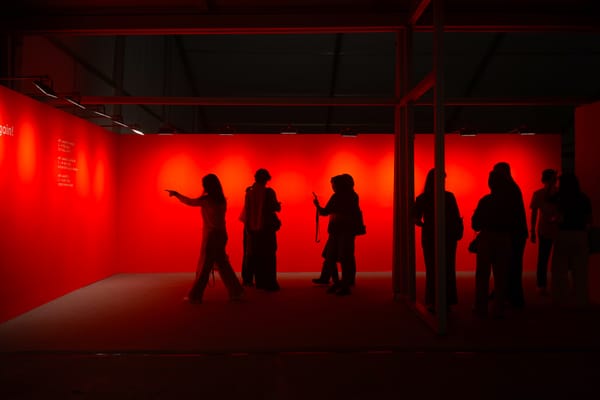Market
Happenings: Frieze Art Fair

HAPPENINGS
Frieze Art Fair
by Helena Reckitt

Now that the brouhaha over Young British Artists has abated, two aspects of the British art scene become apparent. Not only is London a great place to see contemporary art, it also might be a halfway decent place for artists to make a living. The landscape has changed dramatically over the past decade. Funding from the National Lottery has supported major institutions like London's Tate Modern, Gateshead's Baltic and the West Midlands' Walsall Museum. Even more significantly, savvy commercial galleries have emerged to show and nurture challenging new artists.
London's recent Frieze Art Fair underlined these trends. Despite the presence of blue chip galleries from New York and L.A., and hip Tokyo players like Taka Ishii and Gallery Side 2, of the 120 galleries represented the British and Europeans stood "out. Groovy London spaces like The Approach and Cabinet Gallery rubbed shoulders with bastions of the avant-garde, Lisson and Anthony d'Offay, and influential tastemakers, White Cube and Frith Street. The participation of Larry Gagosian and Spr th Magers Lee who have recently established spaces in London indicates that the center of gravity might be shifting from North America to Europe. Strong work at Edinburgh's doggerfisher and Dublin's Kerlin Gallery is evidence that an audience and market exist for artists working throughout the region. Though, Britain's lack of collectors for contemporary work has enabled Charles Saatchi to become a veritable maker and breaker of careers. Yet, the Tate Modern's acquisition of four works at the fair, including a marble sculpture by Yutaka Sone, together with reported large numbers of curators and collectors, signals that this stranglehold might be over.
Organizers, Amanda Sharp and Matthew Slotover, founded Frieze magazine in 1990 in the wake of the YBA generation of Damien Hirst, Gary Hume, Anya Gallaccio, Fiona Rae et al. Frieze has always considered contemporary visual art in relation to popular culture. This cross-fertilization between art and entertainment characterized the program of performances, artists' projects, film and video screenings and lounge acts by the likes of Canadian artist and musician, Rodney Graham, and Pulp frontman, Jarvis Cocker. Panel discussions tackling themes like "The International Curator" and "Empathy and Criticality" added a simultaneously reflective and refreshingly gossipy dimension to the affair.
Perhaps thanks to all this performance, music and talk, as well as the unseasonably warm October weather, the mood was surprisingly unstuffy and upbeat. There is something to savor in the unabashed vulgarity of art fairs as a genre. The sight of a Frank Stella hastily mounted in a cubicle, with chain-smoking dealers, calculators in hand, haggling over its price, offers a bracing reminder about the business of art. Some artists embraced the aesthetics of vulgarity in their work: Hew Locke's gaudy portraits of the British monarch at Hales Gallery were festooned with garlands, small toys and brightly colored crepe paper. Tim Noble and Sue Webster's silhouette of the Manhattan skyline, over at Modern Art, was fashioned from beer cans and cigarette packets. New York's The Wrong Gallery highlighted the ironies of participating in a trade show with a work by Tino Seghal: a couple of children inside an empty booth posed as dealers, only documenting works which were not installed at the fair," and throwing tantrums when anyone tried to photograph them.
I probably won't go to the art fair next year. Call me old-fashioned, but l prefer to view art in the relatively calm environment of the gallery or museum. That said, maybe because the British romance with contemporary art is so recent, and my memory of sparse public support so fresh, it feels churlish to be less than positive about this energetic new event.







